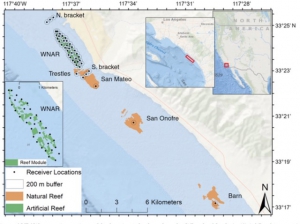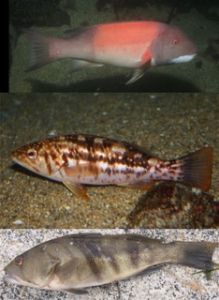A Summary of Acoustic Tagging and Juvenile Salmon Acoustic Telemetry System Program in the Northwestern United States
By Brenna Bales, SRC intern
Before the existence of satellite and acoustic tracking technologies, the most we knew about a certain marine species’ range was from either visual observations or catch data. By developing these systems and scientists cooperating globally by sharing their data, we have learned that some “tropical” species like tiger sharks are not tropical at all but can in fact go as far north as Maine or Canada and out thousands of miles into the mid-Atlantic on a single migration from Florida (sharktagging.com). In 1999, an estimated 11,800 electronic tags (both satellite and acoustic) were placed on marine mammals, fish, invertebrates, reptiles, and birds around the world (Stone et al, 1999). There is a major difference between these two technologies, however. While satellite tags will track an animal wherever it goes as long as it can communicate with a satellite (meaning the tag must hit the surface to be detected), acoustic tags (Image 1) must be within range to an underwater hydrophone for the signal to be detected. This enables acoustically tagged animals to be tracked on a much finer scale without the need for the animal to come to the surface.

Image 1: Differently sized acoustic tags that would be used internally to monitor movements of animals.
A research organization may set up a hydrophone array over a certain area to pinpoint their tagged animals’ locations; however, this array may also detect other animals that have been acoustically tagged by different research organizations. This can be helpful to everyone, as only one hydrophone is needed to track all kinds of animals and their tags, such as sawfish, sharks, and marine mammals; however, private interests may hinder this (Grotheus 2009). Lastly, acoustic tagging has benefits in that it can be used to track multiple individuals within a population in one location versus a small number of animals tracked over different time scales and locations (Huepel et al, 2006).
In 2001, the U.S. Army Corps of Engineers Portland District decided that they wanted to track juvenile salmon in the Columbia river basin through their migration to the Pacific Ocean. There were several goals to the JSATS (Juvenile Salmon Acoustic Telemetry System) project, including 1) assessment of survival and habitat use of juvenile salmonids migrating through the estuarine environment 2) estimation of route-specific dam passage survival of juvenile salmonids 3) determination of fish survival and migration behavior, and 4) to determine effects of water temperature stratification and dissolved gas (https://waterpower.pnnl.gov/jsats/). By 2008, 4,140 JSATS and 48,433 passive integrated transponder (PIT)- tagged yearling Chinook salmon (Oncorhynchus tshawytscha) had been tagged (McMichael et al, 2010). The dams are shown in Image 2 along with the route that the salmon migrated towards the Pacific Ocean.

Image 2: Study area used in JSATS in the Snake and Columbia river basins in 2008. Red circles demarcate the hydrophone array locations and the star marks the release location of the tagged yearling Chinook salmon.
The researchers on the project concluded that the JSATS tags gave more survival location data with higher precision than the PIT tags (McMichael et al, 2010). The JSATS tags also transmitted every 5 seconds, which is optimal for the current study in tracking such small-scale movements around the local dams. All components of the system were non-proprietary, unlike many other arrays currently established. A major outcome from this was the competitive nature in which the U.S. Army Corps of Engineers bid for reductions in sizing and pricing for these tags, leading to many advances in the technology. The study is on-going, and research is being conducted on the biological effects of tagging and how the environment is affecting the receivers and their detection capability. This telemetry system has been designed extremely efficiently and should be used as a model for other up and coming acoustic tagging endeavors.
Literature Cited
Grothues, T.M., 2009. A review of acoustic telemetry technology and a perspective on its diversification relative to coastal tracking arrays. In Tagging and tracking of marine animals with electronic devices (pp. 77-90). Springer, Dordrecht.
Heupel, M.R., Semmens, J.M. and Hobday, A.J., 2006. Automated acoustic tracking of aquatic animals: scales, design and deployment of listening station arrays. Marine and Freshwater Research, 57(1), pp.1-13.
McMichael, G.A., Eppard, M.B., Carlson, T.J., Carter, J.A., Ebberts, B.D., Brown, R.S., Weiland, M., Ploskey, G.R., Harnish, R.A. and Deng, Z.D., 2010. The juvenile salmon acoustic telemetry system: a new tool. Fisheries, 35(1), pp.9-22.
Stone, G., Schubel, J. and Tausig, H., 1999. Electronic marine animal tagging: New frontier in ocean science. OCEANOGRAPHY-WASHINGTON DC-OCEANOGRAPHY SOCIETY-, 12, pp.24-27.
Image 1 source: https://commons.wikimedia.org/wiki/File:Example_of_Acoustic_Telemetry_Tags_for_Fisheries_Research.jpg
Image 2: McMichael, G.A., Eppard, M.B., Carlson, T.J., Carter, J.A., Ebberts, B.D., Brown, R.S., Weiland, M., Ploskey, G.R., Harnish, R.A. and Deng, Z.D., 2010. The juvenile salmon acoustic telemetry system: a new tool. Fisheries, 35(1), pp.9-22.



